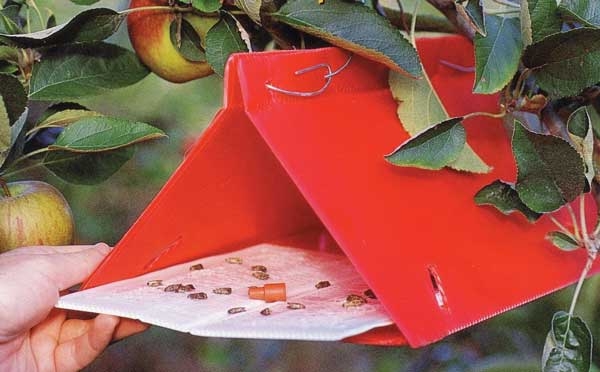The use of traps with an insect sex pheromone lure is the simplest and most accurate way to monitor pests.
The presence (or absence) of these pests in the orchard can be detected and monitored.
Internal fruit feeders like Oriental fruit moth (OFM), codling moth (CM) and Heliothis (native budworm) and the surface feeder, light brown apple moth (LBAM) are the most common moths trapped.
Traps and pheromone lures are also available for San José scale and different traps for earwigs and mealybug.
Monitoring is a critical part of codling moth management. Many orchardists and advisors use phenology models to help with timing of sprays. These models with Biofix and grub hatch dates go together with monitoring and trapping to give a more complete picture of the pest population—where the hot spots are in the orchard, and the best time to spray to control them.
Monitoring is measuring
Pest monitoring is often believed to be too difficult, too time consuming, or simply too confusing to do correctly; but monitoring is just measuring what is difficult to see.
With trapping, moth captures indicate that the pest is active; that treatment may be necessary; and when to spray (if needed).
How traps work
The general principle of how traps work is very basic.
Each trap has a source of pheromone in the lure. The pheromone is usually the sex scent of the female. (Pheromones are chemicals produced by some species of insects to communicate.)
The male pest is lured into the trap by the pheromone. It flies around and lands on a sticky surface.
Why do I need traps?
The new softer, more selective insecticides that are highly specific in the pests they control require precise timing of spray application.
To get the timing right on your orchard, growers need to be fully aware of the stage of the insect pest present. By using the pest information provided by pheromone traps, the pest control effort and expense can be directed specifically for the optimum timing.
How many traps?
A single trap should be used to monitor only a single insect species. At least two traps per species should be used.
In larger blocks (more than 10 ha), at least one trap every 4 ha should be used for a full monitoring program.
Where only the absolute minimum trapping program is to be implemented—and traps will be used only to provide information about the best timing for insecticide applications—at least two traps per pest should be used for each orchard.
Best location
Put traps in locations to catch moths and provide accurate readings of moth pressure (not averages). Place traps to catch the highest numbers—target the hot spots.
Put traps close to the border of blocks—usually in the third row or tree from outside of the orchard.
All traps placed in the orchard should be easily accessible by those who will monitor them.
For codling moth the optimum height is at the top of the tree. For LBAM the best height is 1.5 m from the ground. For OFM the best position is the top third of the tree.
Moth identification - see Insect pest monitoring with pheromone traps (part 2)
SEE A PHEROMONE TRAP WITH CODLING MOTH in the November 2011 Tree Frut




















